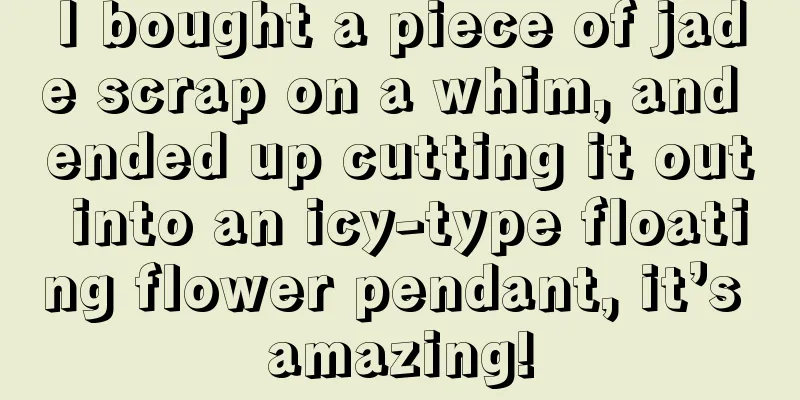The carving process of jade

|
As the ancients said, jade cannot be made into a useful object without being carved. A good piece of jadeite needs to be given a soul through carving techniques. It is not only a true memory of every period of history, but also fully reflects the concept of "Tao is the key to success". The carved patterns in different historical periods demonstrate different charms. Jade and jadeite carvings have also gradually integrated some Western jewelry culture in the long river of history, and gradually embarked on the path of modern carving that combines Chinese and Western cultures. Jade requires a series of complete processing steps from raw materials to finished products, and the various jade carving experiences handed down in our country since ancient times are even more rare treasures; making use of the limited jade materials and magnifying the characteristics of the raw materials not only avoids wasting the raw materials, but also creates beautiful jade. The "Qiao Se" technique, first created by craftsmen in the Song Dynasty, emphasizes that in the process of jade carving, one should pay attention to the natural color and texture of the raw materials, choose the carving subject and specific carving technique according to the materials, avoid unfavorable factors, and cleverly apply patterns and colors. Generally speaking, there are many techniques for jade, such as cutting, smoothing, drawing lines, grooving, hollowing out, tube drilling, punching, hooking, rolling, pushing, bumping, digging, and ring removal. To process jadeite, although carvers in different regions have different techniques and craftsmanship, the basic process is generally the same, mainly including the following steps: 1. Analyze the raw materials and take the materials: mainly analyze the color, texture and cracks of the raw materials. Mainly pay attention to the color trend of the raw materials, the distribution size of each color, the extension position, the specific tone changes, color, transparency, etc. Analyze the texture and see the direction of large and small cracks. 2. Three concepts about jade carving techniques: "clever colors", "two beauties" and "three wonders". Qiao Se refers to the ingenious use of the color of raw materials; Qiao Se value is to highlight the colored parts on the basis of Qiao Se, and color separation means to strictly distinguish the colors of different rows of each part on the basis of Qiao Se, without blurring the boundaries or dragging things out. 3. Cutting and polishing: Cutting refers to cutting the stone. Just use a toothless saw and jade-dissolving sand to break down the stone. Cut along the grain or the direction of the main crack. Polishing refers to using a circular saw and mortar to shape the jade into a general shape. Pecking refers to using carving tools to drill holes or carve patterns. Grinding, as the last step, is to polish the carved jade. After reading this article, please click on the upper right corner to share it to your circle of friends so that more friends can benefit from it! feicuibbs6 |
<<: The birth of a beautiful jade carving, should it be machine-carved or hand-carved?
>>: Jade carving masters, 8 carving techniques you must know
Recommend
The Origin and Meaning of Jade Ruyi
The "Jade Ruyi" is a special jade carvi...
Why are there such huge differences in the charges for jade carving? Let you know the standard of jade processing fee
The current market for jade processing is divided...
Moshisha jadeite rough stone cuts out rare black jadeite, the finished product is amazing
Friends who like to gamble on stones should all k...
What is a good ring face? Have you chosen the right one?
Water quality, color, size, and no cracks. Within...
A visual feast! Use a piece of collection-level Qingshui jadeite to carve Guanyin, the finished product is so beautiful that it is breathtaking
“Jade carvings are either of Bodhisattvas or Budd...
Jade investment value
Jade is a treasure bestowed by nature on mankind....
Why does jade have such a high investment value?
Chinese people like jade. In the past, people car...
These jadeite purchasing points are obviously very important, why are they always overlooked?
When it comes to appreciating jadeite, everyone w...
Don’t mistake “real” jade for “A-grade” jade. Let me teach you how to identify it!
It is a genuine product and it also includes retu...
The pleasing vintage jade earrings have an oriental classical beauty and will never go out of style.
Jade is the stone that best represents the evolut...
Tired of heart! It is very difficult to protect your rights in jade transactions, especially these 5 types!
Rights protection, a word that sounds like a head...
A small piece of jadeite raw stone is turned into a dragon turtle and a Pixiu. Let’s see how it transforms!
The surface texture of the stone is very good, th...
The four major faces of the jade industry, you may not know any of them
The jade world not only has a wide variety of col...
How much do you know about the value of jade?
Maybe buying jade has become a habit for many peo...
Exquisite craftsmanship not only highlights the beauty of the jade raw material itself, but also gives it a higher value.
A high-quality jade product, in addition to havin...









